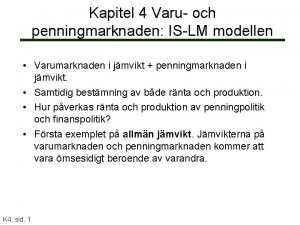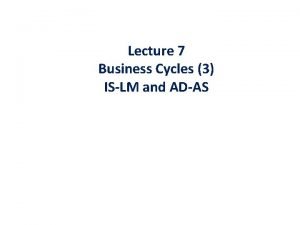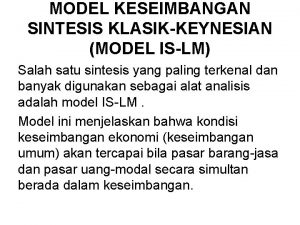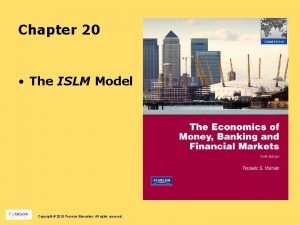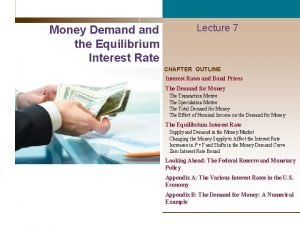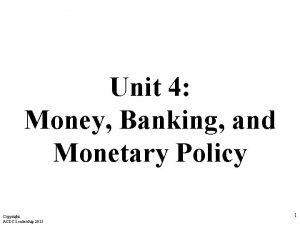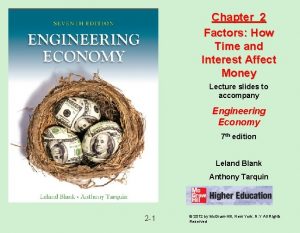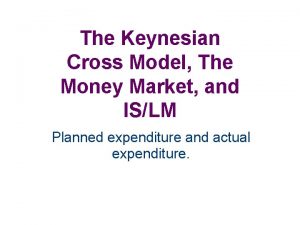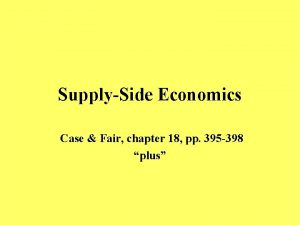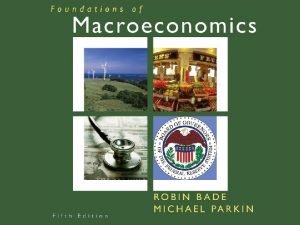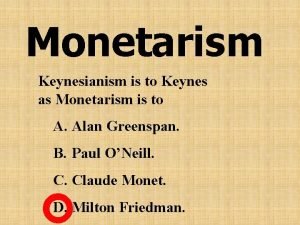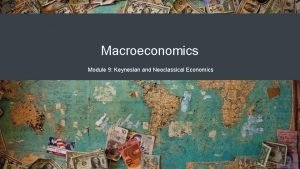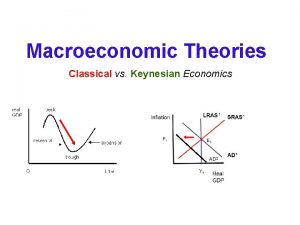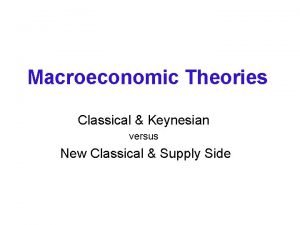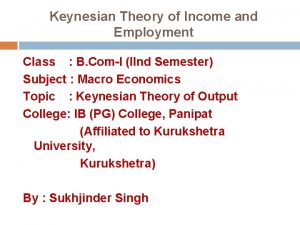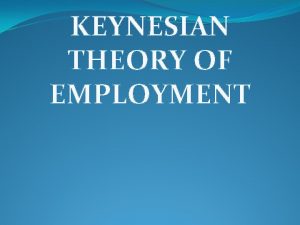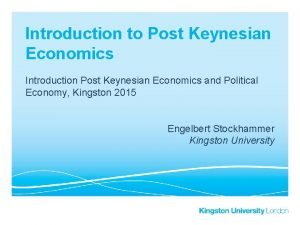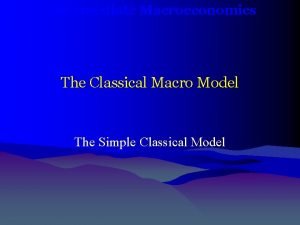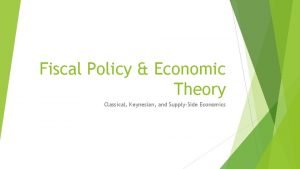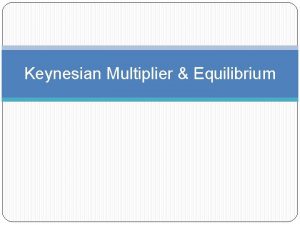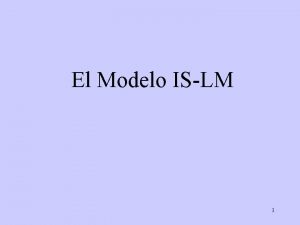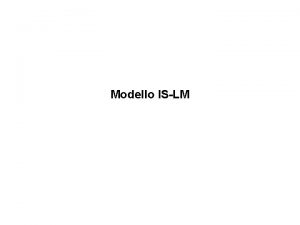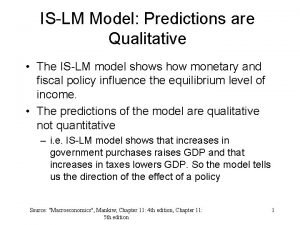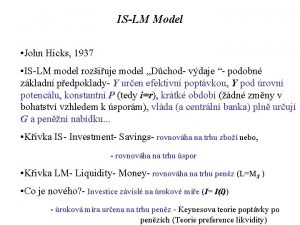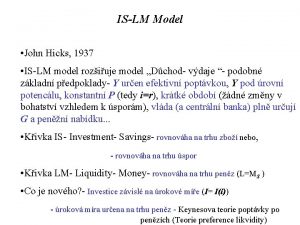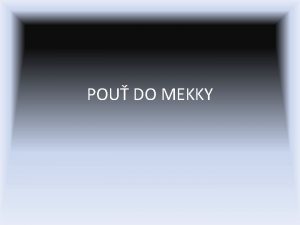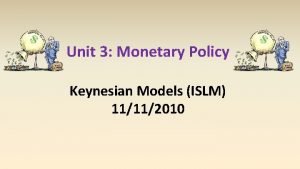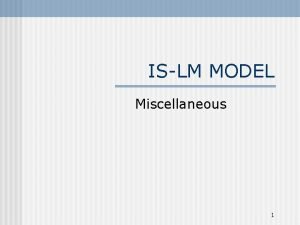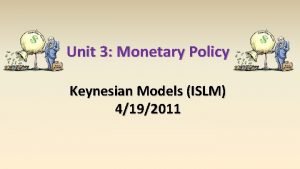Keynesian ISLM The Keynesian System II Money Interest




























- Slides: 28

Keynesian IS-LM The Keynesian System (II): Money, Interest, and Income

Problems with the Income-Expenditure Model l What about prices? – – Don’t they change when AS and AD conditions change? Don’t they have an influence? Are firms really indifferent to changes in the real wage rate? l These issues remain to be addressed. . . l 2

Money in the Keynesian Model l Recall the classical model: – – Transactions motive: people hold money only to make transactions Rejects the store of value theory of the mercantilists, arguing that: • • – Money bears no interest, and A rational person would not forego a positive return by holding money unless he/she planned to make a transaction. People do not hoard money. 3

Liquidity Preference Theory l Money is: 1. 2. 3. l A Medium of Exchange A Store of Value A Unit of Account The first two create demands for money. 4

Liquidity Preference Theory l l Transactions Motive—yields transactions demand for money Store of Value—yields: – – l Precautionary Motive—yielding precautionary demand for money Speculative Motive—yielding the speculative demand for money There are reasons why someone might rationally hoard money! 5

Speculative Demand (1) Keynes considers a portfolio of financial assets. l All financial assets can be considered as money or bonds: l – – l Money (M): yields no return Bonds (B): yield a return Wh = M + B 6

Speculative Demand (2) l Example—Perpetuity (a bond that never matures): – – – l Bond is issued at $1000 Coupon rate is $50 50/1000=5% Later, market interest double to 10% How much can you sell the bond for? Ans: $500 because 50/500=10% When interest rates rise, bond prices fall capital losses! 7

Speculative Demand (3) People decide to hold money instead of bonds when interest rates get so low that they cannot possibly go lower. The move to money to avoid capital losses. r There is a rational motive for hoarding money!!! r 0 Md Lp = Lp(r) (-) As interest rates fall, Bd 0 and Md . M 8

Precautionary Demand People hold money (“precautionary balances”) for unforeseeable expenses. l These holdings (“balances”) tend to: l – – l Rise with income, and Fall with interest rates. Lp = Lp(Y, r) (+) (-) 9

Ambiguity in the Money Market l In the classical model: – – – l Ms = M 0 (exogenous) Md = Md(Y) We used these relationships to create the AD curve. In Keynes’ model: – – Ms = M 0 (exogenous) Md = L(Y, r) Ms = Md M 0 = L(Y, r) is the money market outcome. 10

Sidenote: Hicks’ Little Apparatus Sir John Hicks, 1939, “Mr Keynes and the Classics, a Suggested Interpretation” l Introduces the IS-LM Model as a way of making sense of Keynes’ General Theory. l 11

Keynesian “Money Market” l l M 0 = L(Y, r) is the equilibrium in the money market. There is not one single variable that can change to clear the market. There are two! The “money market” cannot tell us alone what the supply and demand for money will be. Money is not dichotomous. 12

Hicks’ Interpretation: LM Curve r LM Curve (L=M): all those combinations of real interest rates and income which bring the money supply equal to money demand. LM Y 13

LM Curve Slopes Upward Because. . . l l Ms Assumes = M 0 (exogenous) If Y increases, transactions and precautionary demand increase. – – l There will be excess demand in the money markets Interest rates will be driven upward So Y r , and the LM Curve slopes upward. r r 1 r 0 Ms Md(Y 1) Md(Y 0) M 14

LM Curve Slopes Upward Because. . . Liquidity Preference is: L = L(Y, r) Money Supply is: Ms = M 0 = M Ms = Md implies M = L(Y, r) LM Curve Differentiating: 15

LM and the Money Market r LM r Ms Md(Y 2) r 1 Md(Y 1) r 0 Md(Y 0) M Y 0 Y 1 Y 2 Y 16

Changes in Money Supply r Ms Ms Ms r* Md M 17

Capital Market l l l l Investment I = I(r, E) = I(r) But Saving S = S(Y) or S(Yd) So there is not a single “price variable” to clear the capital market! I(r) = S(Y) IS Curve: IS = IS(Y, r) IS: all those combinations of Y and r which make the “capital market” clear. Equivalently, IS is all those combinations of Y and r for which supply = demand in the loanable funds market. Thus the real sector cannot be resolved without considering money market outcomes. – Money is NOT dichotomous. 18

IS Curve r Slopes downward because r I Y IS Y 19

IS Curve Slopes Downward Because. . . Recall that: I+T=S+G or I(r) + T 0 = S(Y) + G 0 Differentiate implicitly with respect to Y and r: 20

r S S I 0 = S 0 r 2 I 1 = S 1 r 0 I 2 = S 2 I I 2 I 1 I 0 I Y 2 Y 1 Y 0 Y r 2 r 1 r 0 IS Y 2 Y 1 Y 0 Y 21

Money and Investment r The interest rate is determined in the money market. Decision makers in firms compare this rate to the MEC and make the decision regarding investment. r Ms r* I Md M* M I* I The real and monetary sectors are linked. Money matters! 22

IS-LM r n Note that the real and monetary sectors of the economy are resolved together. LM n Money matters to real sector outcomes. r* IS Y* Y n There is no dichotomy. 23

Money-Income Transmission The Keynes Effect (Money Income Transmission Mechanism): • Money is not neutral (in the short run), and there is no dichotomy. • Some modern Keynesians argue for long-run neutrality, but short-run nonneutrality. • Changes in the money supply affect the real sector through the interest rate channel. 24

Notes on IS-LM l l LM is a stock equilibrium (beginning of period. IS is a flow equilibrium (end of period). The equilibrium is an equilibrium of flows constrained by stocks. It is a cash-flow equilibrium. The time frame is long enough for full adjustment of real income and interest, short enough so stocks do not change. IS-LM equilibrium is not permanent. S>0 implies that wealth (allocations) are increasing over time. Therefore LM is shifting due to the stock of bonds. If net investment is positive, then the capital stock grows. 25

Linearized IS-LM 26

Linearized IS-LM r* IS Y* Y 27

Classical Model? ( =0) r LM r* IS Y* Y 28
 Money money money team
Money money money team Varumarknaden
Varumarknaden Islm adas
Islm adas Model keseimbangan keynesian
Model keseimbangan keynesian Islm
Islm Real vs nominal interest rate
Real vs nominal interest rate Effective interest rate
Effective interest rate Simple interest
Simple interest Money demand and interest rate
Money demand and interest rate Money supply and interest rate
Money supply and interest rate How time and interest affect money?
How time and interest affect money? Symbolism of the green light in great gatsby
Symbolism of the green light in great gatsby Money smart money match
Money smart money match Money on money multiple
Money on money multiple The great gatsby historical background
The great gatsby historical background Old money vs new money
Old money vs new money Keynesian cross diagram
Keynesian cross diagram Conclusion of money market
Conclusion of money market Supply side economics vs keynesian
Supply side economics vs keynesian Classical keynesian and monetarist
Classical keynesian and monetarist Monetarism vs keynesianism
Monetarism vs keynesianism Economics keynesian vs classical
Economics keynesian vs classical Classical economics vs keynesian
Classical economics vs keynesian Monetarist vs classical economics
Monetarist vs classical economics Explain the keynesian theory of employment
Explain the keynesian theory of employment Keynesian and classical theory
Keynesian and classical theory Classical economics vs keynesian
Classical economics vs keynesian Keynesian consumption function
Keynesian consumption function Keynesian economics policy
Keynesian economics policy

